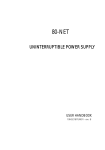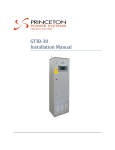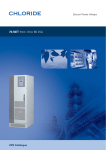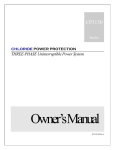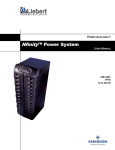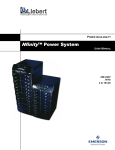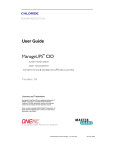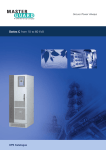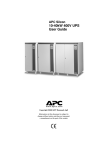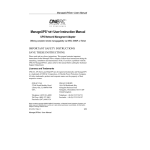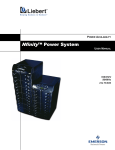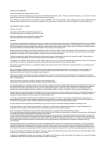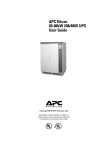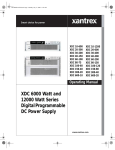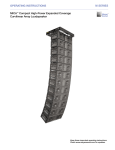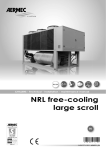Download 70-NET 50-60 kVA UNINTERRUPTIBLE POWER SUPPLY SYSTEM
Transcript
70-NET 50-60 kVA UNINTERRUPTIBLE POWER SUPPLY SYSTEM THREE-PHASE OUTPUT USER HANDBOOK 10H52172UM01 - rev. 5 CHLORIDE 70-NET - 50/60 kVA All rights, including rights of translation, reproduction by printing, copying or similar methods, even of parts, are reserved. Offenders will be liable for damages. All rights, including rights created by patent grant or registration of utility model or design, are reserved. Delivery subject to availability. Right of technical modification reserved. The 70-NET may differ from the one displayed on the front cover. Page 2 User Handbook 10H52172UM01 - Rev. 5 - 04/2008 CHLORIDE 70-NET - 50/60 kVA 1. SAFETY.................................................................................................................................. 5 1.1. INTENDED USE ................................................................................................................................................ 5 1.2. WARNING NOTICE .......................................................................................................................................... 5 1.3. SAFETY NOTICES ............................................................................................................................................ 5 1.4. OVERHEATING ................................................................................................................................................. 6 1.5. EMERGENCY MEASURES ................................................................................................................................. 6 1.6. DANGER AREAS .............................................................................................................................................. 6 1.7. LEAKAGE CURRENTS ....................................................................................................................................... 7 1.8. RADIO FREQUENCY INTERFERENCE .................................................................................................................. 7 1.9. BATTERIES - (EXTERNAL ONLY)....................................................................................................................... 7 1.10. RE-PACKAGING ............................................................................................................................................. 7 2. INTRODUCTION................................................................................................................... 9 2.1. 2.2. 2.3. 2.4. NOTES TO THE EC DECLARATION OF CONFORMITY ......................................................................................... 9 SYMBOLS AND PICTOGRAMS .......................................................................................................................... 9 TERMS USED................................................................................................................................................... 9 DOCUMENTATION STRUCTURE ........................................................................................................................ 9 3.1. 3.2. 3.3. 3.4. 3.5. 3.6. 3.7. 3.8. TRANSPORT .................................................................................................................................................... 11 DELIVERY AND STORAGE ................................................................................................................................. 11 UNPACKING .................................................................................................................................................... 11 ENVIRONMENTAL CONDITIONS........................................................................................................................ 12 ACCESS TO AREA ............................................................................................................................................ 12 INSTALLATION SITE ......................................................................................................................................... 12 FRONT PANEL ................................................................................................................................................. 13 FLOOR ............................................................................................................................................................. 14 3. PREPARATION FOR USE .................................................................................................... 11 4. INSTALLATION .................................................................................................................... 15 4.1. ELECTRICAL PREPARATIONS ............................................................................................................................ 15 4.2. PHYSICAL APPEARANCE .................................................................................................................................. 15 4.3. CURRENTS AND SUGGESTED CABLE SIZES ....................................................................................................... 16 4.4. EXTERNAL PROTECTION DEVICES ..................................................................................................................... 16 4.5. BACKFEED PROTECTION .................................................................................................................................. 18 4.6. EXTERNAL ELECTRICAL CONNECTIONS ............................................................................................................. 19 4.7. POWER CONNECTIONS .................................................................................................................................... 19 4.8. CONNECTING THE BATTERIES .......................................................................................................................... 20 4.9. CONNECTIONS BETWEEN BATTERY CUBICLES AND UPS................................................................................. 21 4.10. HANDLING THE BATTERIES ............................................................................................................................ 23 5. INTERFACES......................................................................................................................... 25 5.1. 5.2. 5.3. 5.4. SERIAL INTERFACES ........................................................................................................................................ 25 VOLTAGE FREE CONTACT PORTS - X7.............................................................................................................. 26 EMERGENCY POWER OFF (E.P.O.) - X8.......................................................................................................... 26 SIGNAL CABLES .............................................................................................................................................. 27 6.1. 6.2. 6.3. 6.4. 6.5. 6.6. 6.7. 6.8. 6.9. FUNCTION ....................................................................................................................................................... 29 SPECIAL FEATURES ......................................................................................................................................... 29 BLOCK DIAGRAM............................................................................................................................................. 30 MAINTENANCE BYPASS .................................................................................................................................. 31 OPERATING MODES ........................................................................................................................................ 32 COMMISSIONING ............................................................................................................................................ 33 UPS OPERATING PROCEDURES ....................................................................................................................... 34 CONTROL PANEL AND DISPLAY ....................................................................................................................... 35 INVERTER STOP/START PROCEDURES .......................................................................................................... 36 6. NORMAL AND SAFE OPERATION .................................................................................... 29 User Handbook 10H52172UM01 - Rev. 5 - 04/2008 Page 3 CHLORIDE 70-NET - 50/60 kVA 6.10. CONTROLS AND MESSAGES .......................................................................................................................... 38 6.11. WARNING AND FAULT INDICATIONS ............................................................................................................. 41 6.12. TROUBLESHOOTING....................................................................................................................................... 43 7. MAINTENANCE................................................................................................................... 45 7.1. 7.2. 7.3. 7.4. 7.5. 7.6. MAINTENANCE INTERVALS ............................................................................................................................. 45 DISPOSAL OF BATTERIES ................................................................................................................................. 45 REPLACING FANS ............................................................................................................................................ 45 SERVICE ADDRESSES....................................................................................................................................... 45 DECOMMISIONING .......................................................................................................................................... 45 DISPOSAL ....................................................................................................................................................... 45 8.1. 8.2. 8.3. 8.4. COMMISSIONING ............................................................................................................................................ 47 SYSTEM CONFIGURATIONS ............................................................................................................................. 47 COMMUNICATION BETWEEN THE UPS BLOCKS .............................................................................................. 47 PARALLEL SWITCHING PROCEDURES ............................................................................................................... 47 8. PARALLEL OPERATION...................................................................................................... 47 9. OPTIONS .............................................................................................................................. 51 9.1. EXTERNAL BATTERIES..................................................................................................................................... 51 9.2. EMPTY OPTIONS CUBICLE ............................................................................................................................... 51 9.3. INPUT LOW THDI OPTION ............................................................................................................................... 51 9.4. EXTENDED BATTERY CHARGER ........................................................................................................................ 51 9.5. REMOTE ALARM UNIT ..................................................................................................................................... 52 9.6. BATTERY MANAGEMENT MODULES ............................................................................................................... 52 9.7. SHUTDOWN AND MONITORING SOFTWARE ..................................................................................................... 52 9.8. SHUTDOWN SOFTWARE FOR COMPUTER INTERFACE PORT ............................................................................... 52 9.9. AS400 MULTIPLEX ......................................................................................................................................... 52 9.10. LIFE.NET ...................................................................................................................................................... 52 9.11. PPVIS SURVEYS MONITORING SOFTWARE ................................................................................................. 53 9.12. CONNECTIVITY .............................................................................................................................................. 54 9.13. DUST FILTER ................................................................................................................................................. 54 10. TECHNICAL DATA............................................................................................................. 55 10.1. UPS DEVICES ............................................................................................................................................... 55 10.2. SPECIAL VERSIONS ....................................................................................................................................... 58 Page 4 User Handbook 10H52172UM01 - Rev. 5 - 04/2008 CHLORIDE 70-NET - 50/60 kVA Safety 1. SAFETY 1.1. INTENDED USE This device serves as an uninterruptible power supply (UPS) for connected loads. The device is in compliance with all relevant safety regulations concerning information technology equipment, including electronic appliances for use in an office environment. In certain conditions, external battery packs are connected to the UPS; these may only be connected to the corresponding UPS device. 1.2. WARNING NOTICE Warning CHLORIDE considers the safety of personnel to be of paramount importance. For this reason it is essential that procedures relating to safety be studied before commencing work and properly adhered to thereafter. • The User or Operator may only intervene in the operation of the UPS provided that the instructions laid out in “Normal and safe operation” on page 29 are strictly adhered to. • Installation, as described in “Installation” on page 15 may only be carried out by qualified technicians. • Even when all switches are off and isolators are open, hazardous voltages are present within the UPS; any operation that requires protection panels to be opened and/or removed may be carried out by authorized technical personnel only. 1.3. SAFETY NOTICES Warning Carefully read the following safety notices! Failure to observe the indications may endanger your life, your safety, the reliability of your device or the security of your data. • Use only suitable packaging to transport the device (protect against jolts and shocks). • If the equipment is moved from a cold environment to the operating room, moisture condensation may occur. Before commissioning the device, it must be completely dry. Therefore, an acclimatisation period of at least two hours is required. • The equipment must be installed in accordance with the environmental conditions specified in “Environmental conditions” on page 12 and “Technical data” on page 55 • There is no button on the panel, and no switch inside the UPS, that completely isolates the device (UPS) from the mains. To ensure that the UPS is isolated, disconnect all the power cables. • In case of interruption of the mains voltage, the external battery maintains the power supply to the load. • Lay the cables so that no one can stand on, or trip over, them. When connecting the device to the power supply, follow the instructions in “Installation” on page 15. Ensure that the live input source cannot accidentally be connected to the UPS during installation - see “Electrical preparations” on page 15 and “Normal and safe operation” on page 29. • Ensure that no foreign objects, such as pins, necklaces, paper clips, etc., are left inside the device. • In case of emergencies (e.g. damaged case, controls or power cables, penetration by liquids or foreign materials), switch off the device, disconnect the power cables and contact the appropriate customer service representative. • Do not connect equipment that may overload the UPS (e.g. laser printers) or demand DC-current (e.g. half-wave rectifiers). • The sum of the leakage currents (protective conductor current) of the UPS and the connected devices may exceed 3.5 mA for all ratings. Ensure the UPS is connected to Earth before connecting the power cables. • Do not connect or disconnect data transmission lines during thunderstorms. • Emergency Power Off (E.P.O.) input - X8 - is located on the Connectivity Panel (see Fig. 11 on page 25). When this connection is open, the logic circuit will immediately shut down the UPS output (see Fig. 5.4 on page 27). In order to ensure that wiring installation safety complies to the European HarUser Handbook 10H52172UM01 - Rev. 5 - 04/2008 Page 5 Safety CHLORIDE 70-NET - 50/60 kVA monized Document HD384-4-46 S1, an Emergency Switching Device (E.S.D.) shall be fitted downstream of the UPS. • UPS not suitable for use with permanent IT grounding systems. In such conditions either the T, R, or LAM version should be installed Warning For T, R and LAM versions only: Hazardous voltages are present on the transformers mounted in the battery compartment at the base of the UPS as soon as the unit is connected to the mains supply. This condition is independent of the operation of switches QS1-4. • Certain components are live even with all UPS switches in “OFF”, these must be labelled accordingly. • This device is not equipped with its own mains separation device. You are, therefore, required to provide a mains separation device at the installation site. • In order to guarantee safe working conditions, ensure all voltage sources are isolated before carrying out the power connections. ENSURE CORRECT POLARITY! • The mains supply separation device must be fitted with a warning label that states: “Switch off the UPS supply prior to working on this system!”. 1.4. OVERHEATING Warning To avoid overheating inside the UPS, do not operate the unit with the rectifier running, the Inverter switched off and the Bypass switch open for extended periods. 1.5. EMERGENCY MEASURES In order to conform to the European Standard EN62040-1-1 (par. 5.1.5) , a UPS must be fitted with an Emergency Power Off device (E.P.O.) that can be used to shut down the unit completely in the event of an emergency. 70-NET is equipped with a dedicated user input which is default configured to execute the EPO function. Refer to “Emergency Power Off (E.P.O.) - X8” on page 26 for instructions on how to install an E.P.O. button on this UPS. In the event of an emergency, press the EPO button immediately in order to shut down the entire system. If, for any reason, the EPO fails to switch off the UPS, proceed as follows: • Open the external mains separation device. • Switch off the load • NEVER ATTEMPT TO OPEN OR CLOSE THE UPS BATTERY SWITCH UNDER EMERGENCY CONDITIONS • In case of fire, call the emergency personnel/fire brigade, who must put out any flames using an extinguisher appropriate to the batteries in use. • NEVER ATTEMPT TO EXTINGUISH A FIRE USING WATER AS BATTERIES CARRY LIVE VOLTAGE AT ALL TIMES. 1.6. DANGER AREAS When the UPS is closed, it is not possible to come into contact with live components. After removing the cabinet front door and safety panel, the connection terminals and bars, as well as exposed metal parts and other components carrying dangerous voltages are no longer protected against accidental contact! Page 6 User Handbook 10H52172UM01 - Rev. 5 - 04/2008 CHLORIDE 70-NET - 50/60 kVA Safety Warning The UPS contains capacitors which continue to store energy for a period of time after the device has been disconnected from the mains supply(ies) and battery. This voltage (> 400 V DC) is present at the battery terminals. For this reason, check that the UPS and the external mains separation device are switched off and the battery fuses removed. Before continuing work, measure the voltage at the battery terminals and at the mains input filter and wait until this has dropped to 0 V or wait at least 5 min. after disconnecting. Failure to do this can lead to severe electrical shock and even death. 1.7. LEAKAGE CURRENTS Warning Connect the PE safety conductor before connecting any other cables. 1.8. RADIO FREQUENCY INTERFERENCE Warning 70-NET complies with EMC product standard EN_50091-2 or EN_55022 class RS. To avoid interference, installation restrictions may apply or additional measures may be required. 1.9. BATTERIES - (EXTERNAL ONLY) Battery maintenance must be carried out by authorised personnel. • The batteries installed in the battery extension kits contain electrolytic substances. Under normal conditions the containers are dry, but a damaged battery may leak electrolyte which can be dangerous in contact with the skin and cause irritation to the eyes. Should this happen wash the affected part with copious amounts of water and seek immediate medical advice. • Voltage is present on the battery contacts at all times. • Even when discharged a battery has the capacity to supply a high short circuit current, which, in addition to causing damage to the battery itself and associated cables, may expose the operator to the risk of burns. • Battery voltages can be hazardous. The voltage of a single cell is not dangerous, however a number of such blocks, connected in series, can produce dangerous voltages. During maintenance, disconnect the battery blocks so that not more than five batteries are connected in series. • The batteries are sealed “hermetically”. Periods of storage or disuse may not exceed 6 months, at 20°C, without the batteries being recharged. If this period is exceeded it is essential that the battery be recharged, which requires that the UPS be switched on. Guarantee is void if these instructions are not followed. However, it is advised that recharging be carried out at least once every 4 months. • Since new batteries often do not provide full capacity after an initial charge it may be necessary to carry out a number of discharge/recharge cycles before optimum performance is achieved. • In order to protect the environment batteries must be disposed of in accordance with the regulations governing disposal of toxic and harmful waste. 1.10. RE-PACKAGING To re-package, proceed as follows: Do not pack the equipment until at least six hours have elapsed since the last recharge. Place the equipment in bags made of a material sufficiently porous to allow it to breathe (e.g. 100μm polyethylene). Do not remove air from the packaging. User Handbook 10H52172UM01 - Rev. 5 - 04/2008 Page 7 Safety Page 8 CHLORIDE 70-NET - 50/60 kVA User Handbook 10H52172UM01 - Rev. 5 - 04/2008 CHLORIDE 70-NET - 50/60 kVA Introduction 2. INTRODUCTION This User’s Manual contains information regarding the installation, operation and use of the Uninterruptible Power System (UPS) 70-NET It is advised that this document be consulted before installation of the equipment, whose operation shall only be carried out by qualified personnel. Thereafter, it shall be kept and referred to whenever it is necessary to carry out work on the UPS. 2.1. NOTES TO THE EC DECLARATION OF CONFORMITY 70-NET conforms to the following European directives: 2006/95/EC Directive of the council for adaptation of the legal regulations of the member states regarding electrical equipment for use within specific voltage limits, (superseding the 73/23/EC and successive amendments). 89/336/EC Directive of the council for adaptation of the legal regulations of the member states regarding electromagnetic compatibility, modified by directive 91/263/EC, 92/31/EC and 93/68/EC. Conformity is established through compliance with the following standards: • IEC 62040-1-1 • IEC 62040-3 • EN 50091-2 Additional information regarding adherence to these directives is included in the appendices NSR and EMC of the EU Declaration of Conformity. If needed, the EU Declaration of Conformity can be requested from CHLORIDE. 2.2. SYMBOLS AND PICTOGRAMS The following symbols and pictograms are used in this handbook: Warning Indicates instructions which, if not observed, may result in danger to life, safety, the reliability of your device or data security. Notice Indicates additional information and tips. Indicates a step that you must carry out. 2.3. TERMS USED Service bypass The switch that allows continuous supply to the load via the bypass input mains during maintenance work; also referred to as the maintenance bypass. Electronic bypass A thyristor switch which connects the load directly to mains in event of inverter overload; also referred to as a static switch or static bypass. Qualified personnel Personnel who are familiar with the installation, assembly, commissioning and operation of the product and are qualified to carry out the respective activities. Display The control panel comprises a liquid crystal, alphanumeric display, which provides diagnostic and operational information about the UPS. 2.4. DOCUMENTATION STRUCTURE These instructions may be supplemented with additional sheets, describing specific extensions or options. User Handbook 10H52172UM01 - Rev. 5 - 04/2008 Page 9 Introduction Page 10 CHLORIDE 70-NET - 50/60 kVA User Handbook 10H52172UM01 - Rev. 5 - 04/2008 CHLORIDE 70-NET - 50/60 kVA Preparation For Use 3. PREPARATION FOR USE 3.1. TRANSPORT The equipment must be kept upright at all times and handled with care, damage may be caused if dropped or subjected to severe impact. When moving the equipment with a forklift, secure it against tilting. 3.2. DELIVERY AND STORAGE The goods have been checked thoroughly before dispatch. On receipt check the packaging and ensure that the contents are undamaged. Any damage or missing parts must be reported to the supplier within 8 days of delivery. 3.3. UNPACKING The utmost care shall be taken when removing the packaging in order to avoid damaging the equipment. Check all packaging materials to ensure that no items are discarded. Once the packaging has been removed, the UPS shall be taken off the pallet by removing the protective panel (see Fig. 5 on page 15) and the retaining screws, as illustrated in Fig. 1 on page 11, and lifting it off using a fork lift (max width between forks - 540mm - Ref EN 1757). Note that the retaining brackets must not be unscrewed from the UPS feet. Note also, that when moving the pallet, the maximum distance between forks is 690mm. 45 332.5 45 332.5 45 Figure 1 - Unpacking If it is not intended that the UPS be used within seven days of delivery, attention shall be paid to the storage conditions. • If the batteries or the equipment are to be stored they must be kept in a clean, dry environment and away from extremes of temperatures. User Handbook 10H52172UM01 - Rev. 5 - 04/2008 Page 11 Preparation For Use CHLORIDE 70-NET - 50/60 kVA 3.4. ENVIRONMENTAL CONDITIONS The UPS must be installed vertically, on a level and even surface and in an area protected from extremes of temperature, water and humidity. Do not stack units and do not place objects on top of them. The operating temperature range of the UPS is 0 °C to 35 °C (40°C for maximum 8 hours continuous operation). The ideal environmental temperature range is 15 °C to 25 °C.The battery life is defined at 20°C. Each increment of 10 °C above 25 °C reduces the expected life by 50%. Installation altitude Load in % The maximum operating altitude of the UPS, without derating, is 1000 m. At higher altitudes the load must be reduced according to para. 2. Installation altitude in m Figure 2 - Permissible load dependent on installation altitude 3.5. ACCESS TO AREA The area must have sufficient space for installation manoeuvres to be carried out. Access doors must be wide enough to permit unobstructed transport of the device (See “Installation” on page 15.). 3.6. INSTALLATION SITE The external dimensions of the UPS are as follows (refer also to “Technical data” on page 55): Width (mm) Depth (mm)1 Front panel (mm) Height (mm)2 620 846 620 1780 1 2 This figure includes the handle and front panel - without them the depth is 802mm. Leave a minimum distance of 500mm between the top of the cabinet and the ceiling of the installation area. • No rear wall-distance is required, unless the power cables are routed from above, in which case the distance must be at least equal to the bending radius of the cables in use. Page 12 User Handbook 10H52172UM01 - Rev. 5 - 04/2008 CHLORIDE 70-NET - 50/60 kVA Preparation For Use 3.7. FRONT PANEL Leave additional space in front and to the side of the UPS, so that the front door can be opened through the full 180°. • In order to open the door when other UPS or battery cubicles are installed adjacent to the unit, remove the detachable panel from the front door by sliding it off vertically (see Fig. 3): Figure 3 - Sliding front panel User Handbook 10H52172UM01 - Rev. 5 - 04/2008 Page 13 Preparation For Use CHLORIDE 70-NET - 50/60 kVA 3.8. FLOOR The floor where the UPS is installed must be even and level, its load-carrying capacity must also be sufficient to support the floor loading of the UPS - the UPS footprint is illustrated in Fig. 4, the weight may be found in the Data Tables in chapter “Technical data” on page 55. Floor fixing points - M8 Figure 4 - Footprint Page 14 User Handbook 10H52172UM01 - Rev. 5 - 04/2008 CHLORIDE 70-NET - 50/60 kVA Installation 4. INSTALLATION 4.1. ELECTRICAL PREPARATIONS In order to guarantee safe working conditions, ensure all voltage sources are isolated before carrying out the power connections. ENSURE CORRECT POLARITY! Ensure that the live input source cannot accidentally be connected to the UPS during installation. Notice Installation may only be carried out by qualified technicians and in conformity with the applicable safety standards. For electrical installation, the nominal current rating of the source must be observed. 4.2. PHYSICAL APPEARANCE DISPLAY FRONT DOOR BACKFEED LEDS CONNECTIVITY PANEL E.P.O. MODEM POWER SOCKET POWER BREAKERS ACCESS PANEL PROTECTIVE “KICK” PLATE Figure 5 - Front view, with (left) and without (right) front door User Handbook 10H52172UM01 - Rev. 5 - 04/2008 Page 15 Installation CHLORIDE 70-NET - 50/60 kVA 4.3. CURRENTS AND SUGGESTED CABLE SIZES Use cable cross section and fuses according to Table 1 on page 17. Connect the mains supply cables to the UPS terminals U, V, W and U1, V1, W1, N. Connect the load to UPS terminals U2, V2, W2, N. In the absence of a separate Bypass mains Supply, connect jumpers between U and U1, V and V1, W and W1. The conductor cross sections apply for maximum currents: 1). For PVC-insulated copper cables (at 70 °C). 2). When routed in conduits for electrical installations. 3). When air temperature surrounding the conduits does not exceed 30°C. 4). For cable lengths up to 30 m. 5). For stranded wires up to 35 mm2 and for single wires above 35 mm2. Notice Should there be any variation in the conditions it will be necessary to verify whether the cable dimensions satisfy the requirements of IEC-287 and DIN VDE 0298. In cases where the cables are so long that they cause a drop in voltage of >3%, a larger dimension shall be selected. If predominantly non-linear loads are present in your system, the neutral conductor (N) carries 1.6 times the current of the other conductors and should be dimensioned accordingly. Routing of cables (e.g. mains cables, communication or data lines) to other equipment should be kept separate from that of the UPS (I/P, O/P, and external battery cables). 4.4. EXTERNAL PROTECTION DEVICES This device is equipped with manual switches intended only for Service Bypass and Internal Service operations. It is, therefore, essential that the customer install external protection devices at the installation site. These must be installed near the unit and labelled as the mains separation devices for the UPS. Any devices for protecting the cables external to the UPS must be installed upstream of the unit; such devices must be type GG/GL fuses. Warning The following label must be displayed on all switching devices installed in the same electrical system as the UPS, even when these are located at a distance from the area in which it is located (according to European standard EN 62040-1): ENSURE THAT THE UNINTERRUPTIBLE POWER SYSTEM IS ISOLATED BEFORE WORKING ON THIS CIRCUIT Page 16 User Handbook 10H52172UM01 - Rev. 5 - 04/2008 CHLORIDE 70-NET - 50/60 kVA Installation Table 1 indicates cable dimensions and the protection devices (fuses) which must be installed by the user to protect both these and the equipment. Table 1: Conductor cross sections and fuses of standard UPS UPS devices nominal power kVA 50 60 Mains/Reserve Mains min. conductor cross section [mm²] recommended fuse/breaker[A] 25 80 35 100 Load min. conductor cross section [mm²] max. permissible selective fuse for loads [A] 25 72 35 87 35 50 50 70 1.6 1.6 Battery, external +,min. conductor cross section [mm²] max. possible cross section [mm²] recommended fuse/breakera)[A] Neutral (N) from mains/ to load N, N2 oversize if non-lin. load[coefficient] Type of connector busbars - except for battery connections which are M8 terminals Table 2: Conductor cross sections and fuses of UPS type T and LAM UPS devices nominal power [kVA] 50 UPS version 60 T LAM T LAM Mains/Reserve Mains min. conductor cross section[mm²] recommended fuse/breaker [A] connection: busbar hole fits for screw 25 100 M8x25 70 200 M8x25 35 125 M8x25 95 (2x25) 200 M8x25 Load min. conductor cross section[mm²] max. permissible selective fuse for loads [A] connection: busbar hole fits for screw 25 50 M8x25 70 (2x25) 100 M8x25 25 63 M8x25 70 (2x25) 100 M8x25 35 50 35 50 50 70 50 70 M8 terminals M8 terminals M8 terminals M8 terminals Battery, external +,min. conductor cross section [mm²] max. possible cross section[mm²] recommended fuse/breakera) [A] type of connector Neutral (N) to load N2 oversize if non-lin. load [coefficient] a) 1.6 Efen types available, contact CHLORIDE Technical support Table 3: Tigthening torque Screw size Nm (+/-10%) M8 20 M10 39 M12 68 User Handbook 10H52172UM01 - Rev. 5 - 04/2008 Page 17 Installation CHLORIDE 70-NET - 50/60 kVA 4.5. BACKFEED PROTECTION This feature prevents any potential risk of electric shock on the UPS bypass input AC terminals in the event of a Bypass static switch SCR failure. The control circuit includes a contact, that the customer can use to activate an external isolating device, such as an electromagnetic relay, or tripping coil, which will disconnect the bypass mains supply to the UPS when a backfeed is detected. Such a device must be installed in the Bypass source line if two mains supplies are connected to the UPS - see para. 6 below. The Backfeed contact is located at pins 3 and 4 of XT1 (see para. 7, para. 8, and Fig. 9 on page GB- 20). Mains 2/Reserve External Isolating Device UPS Power Electronics U1, V1, W1 To load U2, V2, W2 N Mains U, V, W N N Relay (NC) XT1 - pins 3/4 (Backfeed contacts) Figure 6 - Backfeed protection - External Isolating Device In double conversion mode (on line) and normal operating conditions this contact is closed (NC), whereas, when a backfeed is detected the contact is open. This event is accompanied by warning message 48 on the LCD display - “Backfeed Protection Active”. There are also two LEDs located on the secondary access panel (see Fig. 5 on page 15), the green one is illuminated during normal operating conditions (no backfeed), while the red one indicates that a backfeed has been detected. To reset the backfeed logic, switch OFF the UPS for a few seconds (see “Switching the UPS OFF” on page 34). In compliance with the Standard IEC/EN 62040-1, the external isolating device, which must be an airgap isolator, in accordance with clause 5.1.4 of the aforementioned Standard, IS NOT supplied with the UPS. Common Mains Supply Where the UPS with the backfeed protection feature is supplied from a common mains, the two sources must be connected together (Mains 2/Reserve U1, V1, W1 to Mains 1 U, V, W and Mains 2/Reserve N to Mains 1 N, respectively) inside the Customer’s mains distribution system, and not by connecting jumpers between the UPS input terminals. Page 18 User Handbook 10H52172UM01 - Rev. 5 - 04/2008 CHLORIDE 70-NET - 50/60 kVA Installation 4.6. EXTERNAL ELECTRICAL CONNECTIONS In order to gain access to the external electrical connections it is necessary to open the front door of the UPS and remove the secondary access panel (see Fig. 5 on page 15). Connect the earth cable (PE) first at . If PEN instead of PE and N is available (TN-C-S system), connect an isolated 25mm2 jumper between and PEN/N inside the UPS. 70-NET may only be used in installations where the Neutral is connected to Ground; for further information please contact CHLORIDE Technical Support. Ensure that the UPS is isolated before removing panels. 4.7. POWER CONNECTIONS Ensure the correct phase sequence of the Input (Mains, Reserve) and Output power connections The power connections (see para. 7) on the front of the UPS are: • U, V, W - MAINS INPUT • U1, V1, W1 - RESERVE MAINS SUPPLY (only at the standard UPS type) • U2, V2, W2 - UPS OUTPUT TO LOAD • D-, C+ - BATTERY TERMINALS) • EARTH • NEUTRAL BAR (PEN/N) QS1 QS4 537 QS3 QS2 U V W 369.5 369.5 U2 V2 W2 U1 V1 W1 278.5 277 PEN N D- C+ XT1 Figure 7 - Power connections standard UPS User Handbook 10H52172UM01 - Rev. 5 - 04/2008 Page 19 Installation CHLORIDE 70-NET - 50/60 kVA QS1 QS4 QS3 QS1 QS2 QS4 QS2 QS3 369.5 369.5 U2 V2 W2 277 278.5 PEN N D- C+ U V W 278.5 277 PEN N U V W D- C+ U2 V2 W2 XT1 Figure 8 - Power connections T-type XT1 Figure 9 - Power connections LAM-type 4.8. CONNECTING THE BATTERIES The UPS is not equipped with an isolating device (fused switch, switch, etc.) for the battery DC power connection. Ensure that such a device is fitted either on the battery supply line, or in the battery cabinet. In the case of Parallel UPS Systems (see chap. 8) with a common battery bank, an additional isolating device (switch) must be installed in the dedicated common battery connection to each individual UPS, so that system maintenance can be carried out correctly. In any event, we advise against using common battery solutions as they reduce the reliability of the system. Before connecting the batteries, please read the notice and warning label on the UPS or battery cubicle. Notice Full safety instructions concerning the use and maintenance of UPS batteries are provided in the appropriate battery manufacturers' manuals. The battery safety information contained in this section relates to key considerations which must be taken into account during the installation design process, and may affect the design outcome, depending on localised conditions. Warning Special care should be taken when working with the batteries associated with the 70-NET. When all batteries are connected together the overall voltage exceeds 500V. It is most important to ensure that the batteries are installed separately, in a purposedesigned, lockable, dedicated battery cabinet or battery room. Battery cabinet specifications can be found in “Battery Management Modules” on page 52 of this manual. Warning In the event of malfunction, the battery shelves and/or cabinet chassis or battery frames may become live! Page 20 User Handbook 10H52172UM01 - Rev. 5 - 04/2008 CHLORIDE 70-NET - 50/60 kVA Installation Notice The requirements of the EC directives are satisfied when battery cubicles are used with original accessories. If alternative batteries are used, you must ensure that the applicable EC directives are met and declare conformity. The UPS must still be parameterised with the service software and fitted with an all-pole disconnecting device and fuses, according to table 1 “Conductor cross sections and fuses of standard UPS”. When dimensioning your battery cables, note the connection tolerances at terminals +/-. Warning ENSURE CORRECT POLARITY ! Notice The most common battery type used in UPS installations is the valve regulated battery. Valve regulated cells are not sealed. The amount of gas given off is less than for flooded cells, but when planning the battery installation, allowance must be made for adequate ventilation and heat dissipation. Valve-regulated cells are not completely maintenance-free. They must be kept clean and their connections checked periodically to ensure they are tight, and that there is no evidence of corrosion. It is inevitable that the batteries will lose some charge during transportation and storage; before attempting to carry out an autonomy test, ensure that the batteries are fully charged as this may take several hours. Cell performance typically improves after a few discharge/recharge cycles. Notice The battery charger is configured for 240 cells valve regulated battery (2.27V/cell). The maximum recharge current setting is specified in tab. 10.1.3 (see: Max. batt. recharge current setting range: 240 cells @ Vi/p = 340 V and nominal load). Several charging methods, based on the type of battery, are available and can be configured by authorized personal only. 4.9. CONNECTIONS BETWEEN BATTERY CUBICLES AND UPS • The battery cubicle should be installed adjacent to the UPS (note the battery terminals are located on the right hand side of the UPS). • Make the ground connections (PE). • Connect the batteries with cables as suggested in Table 1 to terminals + (positive pole) and - (negative pole), and in accordance with the connection diagram. • Connect the cable for the temperature sensor between terminals XT1.1 and XT1.2 of the UPS terminal block and terminals X1.1 and X1.2 of the battery cabinet (para. 10). • Shielded temperature sensor lines must be used between the UPS cabinet and the battery cabinet for EMC interference suppression as specified by EN 50091-2 Class RS. The shielding is to be connected to the UPS. Secure the sensor in the battery cabinet using a cable clamp or similar device. • Before the system starts, ensure that the UPS battery connections polarity is correct. Wrong connections can damage the system and endanger operator safety. User Handbook 10H52172UM01 - Rev. 5 - 04/2008 Page 21 Installation CHLORIDE 70-NET - 50/60 kVA PE - + XT1 PE X1 + PE XT1 1 2 - 1 2 Figure 10 - External Battery Connections Page 22 User Handbook 10H52172UM01 - Rev. 5 - 04/2008 X1 CHLORIDE 70-NET - 50/60 kVA Installation 4.10. HANDLING THE BATTERIES Warning Batteries are a potential source of danger due to their electrical charge and chemical composition. Therefore observe the battery handling instructions of the manufacturer. These usually can be found in the material which accompanies the shipment. Recharging batteries Notice When recharging, observe the indications on the packaging Exchanging batteries Notice Before exchanging batteries, both the batteries in the cubicle, as well as those to be installed must be fully charged. Connecting external batteries Warning If a battery has been disconnected and is to be reconnected, the battery isolator may only be reconnected after you have made certain that voltage with the correct polarity is present in the intermediate circuit (see Connecting the Batteries). User Handbook 10H52172UM01 - Rev. 5 - 04/2008 Page 23 Installation Page 24 CHLORIDE 70-NET - 50/60 kVA User Handbook 10H52172UM01 - Rev. 5 - 04/2008 CHLORIDE 70-NET - 50/60 kVA Interfaces 5. INTERFACES 70-NET is equipped with two slot card bays: • a slot available for use with a connectivity option, typically ManageUPS Net SNMP Adapter. Refer to CHLORIDE Connectivity Solutions for more details about available expansion slot cards (XS3); • a slot for the LIFE.net slot modem (see LIFE.net Software and Installation Instructions 10H52127PAMC), this is fitted as standard (user removable) (XS6); two standard serial interfaces: • a RS232 COM interface configured for use with PPVIS or external connectivity solutions (X3) - this is available when the XS3 slot is empty, or when the MUN card is installed; • a RS232 COM interface for data transfer protocol, modem or external connectivity solutions (X6) this is not available when the slot modem is installed; • an AS400 compatible contact interface for signal exchange (output - X7); • an interface to allow emergency shut down of the Bypass, Inverter and Rectifier (EPO) (input - X8).; All of which are located on the Connectivity Panel (see Fig. 11). Also available are: • external Battery Temperature sensor (input - XT1.1 and 2); • Backfeed Protection activated (output - XT1.3 and 4); The interfaces can be used for: • Direct communication between UPS and computer; • Integration of the UPS as client into a network via MopUPS or ManageUPS (see “AS400 Multiplex” on page 52) • Transfer of operational states to external alarm systems The required communication software and interface cables are available as options. The interfaces can also be programmed via PPVIS (service software tool) for a wide range of functions. The serial interfaces are isolated and RS232 compatible. XS3 XS6 X8 X7 X3 X6 EPO Contacts AS/400 RS 232 Service RS 232 Modem/Multi Figure 11 - Connectivity panel 5.1. SERIAL INTERFACES 70-NET is equipped with a voltage-free contact interface, compatible with IBM AS/400 and other computer types. PPVis configured service interface - X3 The service interface is a 9-pin, female, D type connector for RS232 serial communications configured via the PPVis interface for monitoring and control software (PPVis). The pin functions are as follows: Pin Description Function 2 RXD Receive RS232 3 TXD Transmit RS232 5 Ground RS232 Signal ground RS232 User Handbook 10H52172UM01 - Rev. 5 - 04/2008 Page 25 Interfaces CHLORIDE 70-NET - 50/60 kVA Standard COM interface - X6 This interface, which is the LIFE default port, is a 9-pin, male, D type connector, the pin functions are as follows: Pin Description Function 2 TXD Send RS232 3 RXD Receive RS232 5 RS232 GND Signal ground RS232 The nominal rating of the potential-free contacts is 24V, 1A. 5.2. VOLTAGE FREE CONTACT PORTS - X7 70-NET is equipped with a 24 V, 1 A, voltage-free contact interface, compatible with IBM AS/400 and other computer types. This interface is a 9-pin, female, D type connector, the pin functions are as follows: Pin Description Function 1 BYPASS ACTIVE (NC) Bypass mode: contact open between pins 1 and 5 2 LOW BATTERY (NC) Near end of discharge (in battery mode): contact open between pins 2 and 5 3 SUMMARY ALARM (NC) UPS alarm: contact open between pins 3 and 5 4 AC FAIL (NC) Mains failure: contact open between pins 4 and 5 5 COMMON Common connection for all floating contacts 6 BYPASS ACTIVE (NO) Bypass mode: contact closed between pins 6 and 5 7 LOW BATTERY (NO) Near end of discharge (in battery mode): contact closed between pins 7 and 5 8 SUMMARY ALARM (NO) UPS alarm: contact closed between pins 8 and 5 9 AC FAIL (NO) Mains failure: contact closed between pins 9 and 5 5.3. EMERGENCY POWER OFF (E.P.O.) - X8 For the Emergency Power Off switch function, connect a switch, having the properties of an Emergency Off button, i.e. Normally Closed, held open mechanically when activated, max. connection length 50m, and min. wire cross section 0.75mm2 between the contacts of X8 (not supplied). The interface is a 2 pole screw terminal connector for wires up to 0.75 mm2. To ensure that the installation wiring safety complies with the European Harmonized Document HD3844-46 S1, an Emergency Switching Device (E.S.D.) must be fitted downstream of the UPS. As soon as the emergency condition that triggered the switch has been resolved, switch off all UPS switches (input, output, battery disconnector, and all external battery switches) and repeat the start-up procedure as described in “Normal and safe operation” on page 29. Notice The interface cables must be shielded and located away from the power cables (min. 20 cm). The shield must be connected at both ends. Control and power cables must cross at a 90° angle. Page 26 User Handbook 10H52172UM01 - Rev. 5 - 04/2008 CHLORIDE 70-NET - 50/60 kVA Interfaces 5.4. SIGNAL CABLES The various signal cables from the Connectivity Box can be routed through the bottom of the UPS via a cut-out in the front panel (see Fig. 12). Figure 12 - Signal cable routing Connectivity Box Front Panel Signal Cable(s) Cut-out User Handbook 10H52172UM01 - Rev. 5 - 04/2008 Page 27 Interfaces CHLORIDE 70-NET - 50/60 kVA Parallel signals The Parallel Operating Board (POB) is installed in AP2, which is located behind the upper panel (see Fig. 13), the parallel cables must be routed behind the upper panel (see Fig. 13 - A), through the cut-out (see Fig. 12 - B) and down to join the signal cables from the Connectivity Box (see para 5.4 “Signal cables” and Fig. 12 on page 27). Figure 13 - Parallel signal cable routing - details A B Upper panel Cut-out Parallel Signal Cables Parallel Signal Cables Connectivity Box Signal Cable(s) AP2 Page 28 User Handbook 10H52172UM01 - Rev. 5 - 04/2008 CHLORIDE 70-NET - 50/60 kVA Normal and safe operation 6. NORMAL AND SAFE OPERATION 6.1. FUNCTION The uninterruptible power supply (UPS) is connected between the mains and the electrical load. It protects the load from mains interruptions and power failures. On-line Principle 70-NET operates according to the on-line principle. In on-line operation, the alternating voltage of the mains is converted into direct voltage. This DC voltage is used simultaneously to charge the battery and supply the inverter. The inverter converts the direct voltage into interference-free alternating voltage at a fixed frequency and amplitude, from which are supplied the connected loads. This protects the load from mains supply Figure 14 - UPS in on-line operation disturbances and provides a secure supply for electrical loads (PCs, network servers, multi-console systems). In case of a mains failure, the batteries provide uninterrupted power to the loads for a given period, dependent on battery capacity and connected load. Battery management The battery is charged and discharged, as well as monitored, using a dedicated microprocessor control. This ensures battery lifetime is maximised. For details, see “Special features” on page 29. Overload capacity In the event of overload (e.g. > 150 % of nominal load) or inverter failure, the load is supplied directly by the mains supply via the automatic bypass. As soon as the system returns to normal operating conditions, it automatically switches back to inverter operation. Communication The UPS offers several interfaces for communication with computers. Further information is included in “Interfaces” on page 25. 6.2. SPECIAL FEATURES Safe and reliable operation • Real on-line functioning, i.e. complete de-coupling of the load from all anomalies in the mains supply • The Control Unit (internal processor - CU) supports first class features of the UPS, i.e. vector control, highest flexibility and more. • Electronic bypass increases the reliability of the electrical supply Easy installation and operation • Parameterisation using bundled PC software • No requirement for presence of Operator during normal operation • Simple LCD provides clear indication of status, load and battery quality, clear operating and display concept • Event memory for fault analysis • Fault display and audible signal Battery management • Automatic battery management ensures maximum battery life • Automatic battery circuit test • Temperature-dependent charging Environment, EMC • • • • EMC limits values to comply with European regulations and standards Energy savings due to high efficiency Low noise level Special EMC filter for higher demands (optional) User Handbook 10H52172UM01 - Rev. 5 - 04/2008 Page 29 Normal and safe operation CHLORIDE 70-NET - 50/60 kVA Modern technology • Interfaces with software for all operating systems • IGBT power transistors • Highly integrated digital electronics (ASICs) • Especially well suited for computer loads The UPS can also be used as a frequency converter for 50/60 Hz or vice versa. 6.3. BLOCK DIAGRAM (see para. 15). KEY TO SWITCHES: • QS1 = MAINS INPUT SWITCH • QS2 = ELECTRONIC BYPASS SWITCH • QS3 = SERVICE BYPASS SWITCH • QS4 = OUTPUT SWITCH • QS5 = NEUTRAL BREAKER (for maintenance use only, unauthorised operation can result in loss of load supply) Components The UPS consists of the components: • converter, consisting of rectifier, filter, booster and inverter with integrated battery charger • filter for forming the three-phase sinusoidal output voltage • electronic bypass • reserve mains supply • service bypass for disconnecting the Power Module during servicing, without interrupting the supply to the load • EMC filter • Galvanic Isolation (T Version) and 208V, 60Hz (LAM Version), both of which are optional. Maintenance Bypass U1 V1 W1 QS3 QS2 Electronic Bypass Rectifier U2 V2 W2 U V W QS4 QS1 EMC upgrade and options T or LAM versions Booster/Inverter QS5 Charger N N C+, D- External battery cabinet Battery Figure 15 - UPS Overview Page 30 User Handbook 10H52172UM01 - Rev. 5 - 04/2008 CHLORIDE 70-NET - 50/60 kVA Normal and safe operation 6.4. MAINTENANCE BYPASS This is necessary for maintenance work, as well as for commissioning and putting in and taking out of service. With this mode selected, the loads continue to be supplied without interruption whatever switching actions are carried out. For Maintenance Bypass operation, the power switches QS1, QS2 and QS4 must be switched to the 0 (OFF) position, and QS3 must be switched to the 1 (ON) position. These switches are located on the front of the UPS. After having removed the front panel, the location of the switches can be seen, as in the following figures: Figure 16 - Location of interruptors Warning During parallel operation of UPS units, the load switching function of the built-in service bypass can be carried out by an external switching device (see “Parallel operation” on page 47). User Handbook 10H52172UM01 - Rev. 5 - 04/2008 Page 31 Normal and safe operation CHLORIDE 70-NET - 50/60 kVA 6.5. OPERATING MODES The UPS has four different operating modes. These are described below. On-line operation Normal UPS operating mode. The connected loads are supplied from the mains via the Inverter. The batteries are charged as necessary. The inverter reliably filters mains disturbances and provides a stable, interference-free supply to the load. On the control panel, the “OK” LED is illuminated when the UPS is in on-line operation. In this operating mode, the UPS switches to battery operation if a mains failure occurs. If an overload or short circuit occurs at the UPS output, or if there is a fault in the inverter, the UPS switches to bypass operation. Figure 17 - Power flow in on-line operation Battery operation In this operating mode, the connected load is supplied from the batteries via the inverter. In the event of power failure, battery operation is automatically activated and supplies the loads withput interruption. If the power failure lasts longer than 30 s, the UPS sig- Figure 18 - Power nals a fault condition. flow in battery operation In battery operation, the “OK” (green) LED on the control panel and the “WARNING” (yellow) LED are flashing. From this operating mode, the UPS automatically returns to on-line operation within the backup time once the mains supply returns. If the power failure lasts longer than the loads can be supplied by the battery, the UPS provides relevant information via its interfaces. Computers can be automatically powered down with additional software (optional). Bypass operation In this operating mode, the connected loads are supplied from the mains via the electronic bypass. The electronic bypass serves to further ensure power to the loads. If an overload or short-circuit at the UPS output occurs, it is automatically activated to ensure uninter- Figure 19 - Power flow in bypass rupted power supply to the loads. operation The “WARNING” (yellow) LED on the control panel illuminates. From this operating mode, the UPS automatically returns to on-line operation after the fault is corrected. Bypass operation can also be specifically selected from the control panel with the key switch. Service bypass In this operating mode, the connected loads are supplied directly from the mains supply. There is no supply to the Display/Control Panel in this condition. The service bypass is used to supply the connected loads with voltage during maintenance work on the UPS. Page 32 User Handbook 10H52172UM01 - Rev. 5 - 04/2008 Figure 20 - Power flow in service bypass operation CHLORIDE 70-NET - 50/60 kVA Normal and safe operation 6.6. COMMISSIONING Forming If the UPS devices have not been used for a period of more than two years, it may be necessary to reform the electrolytic capacitors in the rectifier circuit. If the UPS devices are commissioned within two years of delivery (check nameplate), this action is not necessary. Contact customer service if these capacitors need to be reformed. Carry out commissioning as follows: Switch on the UPS • Check that the UPS is connected according to chapter 4 “Installation”. For parallel operation please check “Parallel operation” on page 47. • ensure that the ventilation grilles are unobstructed • ensure the earth connection is in place • ensure that any external switches are in the OFF (0) position • ensure that all external batteries are disconnected • in order to set-up special UPS parameters please download the appropriate Service software from the website: www.masterguard.de and follow → “Service“ → software download PPVis Danger Do not connect any devices that may overload the UPS or draw direct current from it. Notice If these instructions are not observed correctly, problems may be experienced with the electrical supply. • Set the UPS to Maintenance Bypass operation (see “UPS operating procedures” on page 34). • Connect a PC to the service interface X3 (see “PPVis configured service interface - X3” on page 25) and set the correct battery data, if necessary, using the software provided with the shipment. Switch to on-line operation • Set the UPS to On-line Operation (see “UPS operating procedures” on page 34). The UPS is now in on-line operation and the loads are supplied from the inverter. Message 8 disappears from the display. Connection of external batteries Before the system starts, ensure that the UPS battery connections polarity is correct. Wrong connections can damage the system and endanger operator safety. While the UPS is in normal operating mode, check that the battery charging voltage is present on the UPS side of the battery isolator. Situation 1 : DC voltage present • Ensure the polarity of the DC voltage on the battery side is the same as that on the UPS side. • Insert the battery fuses and close the battery switch. Warning indicator 13 is extinguished on the display Situation 2: No DC voltage present The UPS may be fitted with an upgraded charger module which detects reversed connect battery (feature: Battery Reverse Detection). A charger having this feature provides charging only if the batteries are connected correctly. If no battery is connected, no charging voltage is present. If the UPS already has this feature, proceed as follows: • Connect the battery, via the battery breaker, directly to the charger • If the polarity is correct, indicator 13 is extinguished on the display • If the polarity is incorrect, indicator 13 remains illuminated - swap battery connectors over and try again. User Handbook 10H52172UM01 - Rev. 5 - 04/2008 Page 33 Normal and safe operation CHLORIDE 70-NET - 50/60 kVA 6.7. UPS OPERATING PROCEDURES Procedures refer to para. 15. Table 4: Switching the UPS ON Step Action 1 Switch QS1 to ON 2 Switch QS2 to ON 3 Switch QS4 to ON 4 Connect the external battery by switching the battery separating device (see “Connecting the batteries” on page 20) to ON 5 Press Inverter ON on Display Panel (Fig. 21) for 5 seconds Status Bypass Mode (load supplied from Bypass) Normal Mode (On Line) Table 5: Switching the UPS OFF Step Action 1 Press Inverter OFF on Display Panel (Fig. 21) for 5 seconds 2 Disconnect the external battery by switching the battery separating device (see “Connecting the batteries” on page 20) to OFF 3 Switch QS4 to OFF 4 Switch QS2 to OFF 5 Switch QS1 to OFF Status Bypass Mode (load supplied from Bypass) Load no longer supplied UPS OFF Table 6: Transfer from On-line to Maintenance Bypass operation Step Action Status 1 Press Inverter OFF on Display Panel (Fig. 21) for 5 seconds Normal Mode (Automatic bypass) 2 Disconnect the external battery by switching the battery separating device (see “Connecting the batteries” on page 20) to OFF 3 Switch QS3 to ON 4 Switch QS4 to OFF Service Mode 5 Switch QS1 and QS2 to OFF Maintenance Bypass Mode Table 7: Transfer from Maintenance Bypass operation to On-line mode Step Action 1 Switch QS1 and QS2 to ON - Await Bypass Mode ON 2 Switch QS4 to ON 3 Switch QS3 to OFF 4 Connect the external battery by switching the battery separating device (see “Connecting the batteries” on page 20) to ON 5 Press Inverter ON on Display Panel (Fig. 21) for 5 seconds Page 34 Status Service Mode Normal Mode (On Line) User Handbook 10H52172UM01 - Rev. 5 - 04/2008 CHLORIDE 70-NET - 50/60 kVA Normal and safe operation 6.8. CONTROL PANEL AND DISPLAY The control panel serves as the UPS user interface. An LCD informs the user about the operating status of the UPS. A single-line diagram of the UPS is continuously displayed on the default page. The main functional blocks and power paths of the UPS are displayed using standard technical symbols, instantly communicating the overall status of the UPS. The same screen also permanently displays the output load percentage measurement, using three histograms (one for each output phase). When the UPS is not in normal operating mode, it is possible to access the "Warning and Alarm" summary page directly from the default page. Warnings and alarms are identified by text strings and codes. In battery operation, the display switches between warning code and estimated backup time (minutes). After 30 seconds of inactivity (i.e. without buttons being pressed) the display reverts to the default page. The text displayed by the LCD is available in English, Italian, French, German, Spanish, Portuguese, Turkish and Chinese, selectable by the user. See the tables on the following pages for an overview of the Display Message Structure. Modifications and settings as shown below in menus 21/22/23 may only be carried out by appropriately qualified tecnicians. Settings should be tested only if the loads supplied by the UPS are non-critical. OPERATING PROCEDURES • Start Inverter Press the Inverter ON • Stop Inverter Press the Inverter OFF period. button for five seconds. button for five seconds. An audible alarm will sound during this delay • Silencing Buzzer To silence the Buzzer press the Reset button momentarily • Fault Reset In order to restore normal operation of the UPS following a fault condition, after having corrected the situation causing the fault, press the Reset button for at least one second. • General Status LED Three LED indicators provide a quick, general understanding of the status of the UPS, as described below: OK LED (green) Normal Operation When this light is on (not flashing), the system is running normally and neither warnings nor alarms are present. During mains failures (all other conditions at being nominal level), this LED will flash. Warning LED (yellow)Warning Condition(s) present This indication shall be activated by the presence of anomalous conditions, which could affect the nominal functioning of the UPS. These conditions are not originated with the UPS, but may be caused either by the surrounding environment or by the electrical installation (mains side and load side). It shall be possible to read the description of the active warning(s) by browsing the relevant LCD display menus. Alarm LED (red) Alarm Condition When this light is on, immediate attention should be given to the severity of the alarm, and service should be called promptly. It shall be possible to read the description of the active alarm(s) by browsing the relevant LCD display menus. User Handbook 10H52172UM01 - Rev. 5 - 04/2008 Page 35 Normal and safe operation CHLORIDE 70-NET - 50/60 kVA 6.9. INVERTER STOP/START PROCEDURES In the course of operating the UPS, it may become necessary, for example in an emergency situation, to switch off the Inverter, this is done by pressing the Inverter Stop button (see Fig. 21 - on page 37) and observing the following procedures: Single UPS - Bypass normal In this condition, press, and hold, the Inverter Stop button, for the first two seconds the buzzer sounds (tone #1 - continuous "beep"), if the button is released during this period the operation of the UPS is not affected and the Inverter remains on. After two seconds, the buzzer stops, and an warning message is indicated (warning and fault messages may be viewed by scrolling through the Display Menus as described in “Controls and messages” on page 38): INVERTER INVERTER OFF at which point the Inverter is switched off, the load is supplied by the Bypass and the Inverter Stop button can be released Parallel UPS - Normal operation - Stop inverter To switch off the Inverters of the UPS in a parallel system, press, and hold, the Inverter Stop button on each UPS control panel, one by one, the buzzer sounds (tone #1 - continuous "beep"), then, after two seconds, the message: UPS xxxkVA STOP IN STANDBY may be viewed (see “Controls and messages” on page 38), and the buzzer is silenced, while the Inverter continues to supply the load Once the last Inverter Stop button has been pressed for two seconds, all the Inverters in the system switch off and the Load is transferred to the Bypass supply. Until all the Inverters have switched off and the Load is transferred to the Reserve, the "STOP IN STANDBY" command may be reset on any, or all, of the UPS, by pressing the Inverter Start button on the control panel for a minimum of two seconds. Refer also to “Warning and Fault indications” on page 41 Parallel UPS - Start Inverter To switch ON the Inverters of the UPS in a parallel system, press, and hold, the Inverter Start button on each UPS control panel, one by one, after two seconds, the message: UPS xxxkVA START IN STANDBY may be viewed (see “Controls and messages” on page 38). Once the last Inverter Start button has been pressed, all the Inverters in the system switch ON and the Load is supplied from the Inverters. Until all the Inverters have switched ON the "START IN STANDBY" command may be reset on any, or all, of the UPS by pressing and holding the Inverter Stop button on the control panel for a minimum of two seconds. . Refer also to “Warning and Fault indications” on page 41 Page 36 User Handbook 10H52172UM01 - Rev. 5 - 04/2008 CHLORIDE 70-NET - 50/60 kVA Normal and safe operation Display “Menu Up” Button “Select Right” Button “Select Left” Button “Inverter ON” Button “Menu Down” Button “Fault” LED (red) - Flashes if FAULT condition message is present “Inverter OFF” Button “Reset” Button “OK” LED (green) - Illuminated when Load is on Inverter - Flashing when when Load is on Battery “Warning” LED (yellow) - Flashes if WARNING condition message is present Figure 21 - Control Panel The TEST / RESET button serves as a function control for the LEDs of the control panel and resets the UPS after the fault has been corrected. All LEDs on the control panel illuminate for approx. 1.5 s after pressing the button in normal operation (no warning or fault indicators present), followed by the last five warning indicators appearing one after the other in the two-digit display. If a fault occurs, pressing the button mutes the audible signal and, once the fault has been corrected, pressing the button brings the UPS into operation again. The UPS can be manually switched between bypass and on-line operation using the keys “Inverter ON” (I) and “Inverter OFF” (O). A PC can be connected to the service plug (SERVICE) via the serial interface (RS232). Using the service software included with the unit, settings of the UPS can be changed and the UPS data can be queried. User Handbook 10H52172UM01 - Rev. 5 - 04/2008 Page 37 Normal and safe operation CHLORIDE 70-NET - 50/60 kVA 6.10. CONTROLS AND MESSAGES The display provides the following structure of windows. Each window has an dedicated number (see figure). By pressing the keys “menu up” or “menu down” a walk through the windows can be made. If it is necessary to modify the settings in menus 21/22/23 the UPS must be switched to Automatic Bypass. 1 2 1 1 M e a s u re d v a lu e s w in d o w s M e a s u re d v a lu e s m e n u 1 1 2 1 2 2 U P S s e ttin g s m e n u 3 2 3 1 B a tte ry te s t U P S s e ttin g s c h o o s e n e w v a lu e U P S s e ttin g s w in d o w s 3 3 3 4 W a it e n d o f te s t 4 2 M a in M e n u R e s e t d e la y e d c a ll 4 1 3 3 5 2 S y s te m b lo c k d ia g r a m L ife 2 0 0 0 s ta tu s W a r n in g + F a u lt D ia g n o s is M a n u a l c a ll re q u e s t S e t/R e s e t S e r v ic e m o d e L a n g u a g e s e ttin g s 5 1 D is p la y s e ttin g s C o n tra s t s e ttin g s 4 3 4 4 5 2 5 3 6 1 A b o u t Figure 22 - - System block, main- and submenus Page 38 U P S s e ttin g s r e s u lt L a s t te s t d a te + r e s u lt C h o o s e te s t 1 2 3 User Handbook 10H52172UM01 - Rev. 5 - 04/2008 D is p la y te s t r e s u lt CHLORIDE 70-NET - 50/60 kVA Normal and safe operation Table 8: Displayed Text - System Block and Main Menu N°. Description 1* SYSTEM STATUS “Load” 2* MAIN MENU “Actual Values” “Back-up: .. in minutes” Presentation of “System Block Diagram” “UPS Settings” “Battery Test” “LIFE” “Display Settings” “About” 3* WARNING/ FAULT DIAGNOSIS For information on Warning and Fault messages, refer to para 6.11 “Warning and Fault indications” Table 9: Displayed Text - Sub Menus N°. Description 11* - MEASURED MENU UPS Input UPS Output DC Link Battery 12* - MEASURED VALUES V Mains L1 Real Power Out V Mains L2 Real Power Out L1 V Mains L3 Real Power Out L2 Mains Frequency Real Power Out L3 V interm. circ. Tot. Real Power Out V interm. circ. + App. Power Out L1 V interm. circ. - App. Power Out L2 V Output L1 App. Power Out L3 V Output L2 Tot. App. Power Out V Output L3 Overload Threshold Output Frequency V Batt. per Cell I Output L1 Batt. Temp. I Outout L2 Batt. Current I Output L3 Actual Capacity Output Frequency Hold up Time User Handbook 10H52172UM01 - Rev. 5 - 04/2008 Page 39 Normal and safe operation CHLORIDE 70-NET - 50/60 kVA Table 9: Displayed Text - Sub Menus N°. 21* - UPS SETTING MENU Description Input Contact Other 22* - UPS SETTINGS MENU slot 2 slot 1 Optional Boards (comms. box slot numbers - see right) slot 3 Output Contact C o m m u n ic a t io n b o x ( C U 4 / P O B / P r o f ib u s ) Input Contacts Function AK3 Function EK1 On Delay AK3 On Delay EK1 Off Delay AK3 Off Delay EK1 Negate Output AK3 Negate Input EK1 Function AK4 Output Contacts On Delay AK4 Function AK1 Off Delay AK4 On Delay AK1 Negate Output AK4 Off Delay AK1 Optional boards Negate Output AK1 Board in slot 3 Function AK2 Profibus Bus Addr. On Delay AK2 Profibus PZD5 Off Delay AK2 Profibus PZD7, PZD8 Negate Output AK2 Profibus PZD9 23* - SETTING VALUE AND RESET Parameter cannot be changed, verify if UPS has to be in Bypass Mode 31* - BATTERY TEST MENU Test Status Perform a Test 32* - BATTERY Last Test Result TEST STATUS Last Test Date (Window: Last Test Date OK... and Result) Failed... 33* - BATTERY TEST START (Window: Choose Test) 34* - BATTERY TEST in Progress (Window: Wait end of Test) Page 40 10 Second Test 8 Minute Test 1 Minute Test 10 Minute Test 2 Minute Test 15 Minute Test 4 Minute Test 20 Minute Test 6 Minute Test Autonomy Test Capacity: Remaining: Autonomy User Handbook 10H52172UM01 - Rev. 5 - 04/2008 CHLORIDE 70-NET - 50/60 kVA Normal and safe operation Table 9: Displayed Text - Sub Menus N°. Description 35* - BATTERY TEST RESULT (Window: Display Test Result) Test not possible at this time Result: OK Test Cancelled Result: Failed Test passed Measured Autonomy 41* - LIFE MENU (Window: LIFE Status) LIFE not Active on this UPS Wait Connection Next Call Date Connected Next Call Time Send LIFE Data Delayed call In (> Window 42) Send Easy Data Connection Status PPVIS Connection Call Type (> Windows 43) Close in Progress Service Mode (> Window 44) Call Rescheduled UPS not Connected 42* - LIFE DELAYED Reset Delayed Call? 43* - LIFE MANUAL Perform a Manual Call 44* - LIFE SERVICE Enter Service Exit Service 51* - DISPLAY SETTINGS Language Contrast 52* - LANGUAGE SETTINGS English/Deutsch/Français/Italiano/Spanish/Portuguese/Chinese 53* - CONTRAST SETTINGS Contrast: Up or Down 61* - ABOUT Manufacturer LCD Firmware Date Type of UPS CU Firmware part No. Website CU Firmware Rev. LCD Firmware Part No. CU Firmware Date LCD Firmware Rev. 6.11. WARNING AND FAULT INDICATIONS The UPS recognises and draws attention to a number of events occurring during operation. These events are divided into Warning and Fault indications. Whether the message is a warning or fault can be determined from the number which appears in the Warning/Fault Diagnosis page of the display, and the buzzer signals. The buzzer has two different patterns, which indicate the tyre of warning active. • Pattern 1: long intervals - This event is less serious. It is not essential that the cause be rectified immediately, unless otherwise specified in table “Warning indicators” . • Pattern 2: short intervals - This is a serious event. The cause should be rectified straight away to avoid a fault condition. The buzzer is silenced automatically as soon as the cause of the event is rectified. It can also be silenced manually by pressing the button TEST/RESET. Warning indicators If a warning indication appears, the UPS continues to operate. The yellow LED ALARM illuminates on the control panel. A number between 1 and 31 appears in the display indicating the type of warning. User Handbook 10H52172UM01 - Rev. 5 - 04/2008 Page 41 Normal and safe operation CHLORIDE 70-NET - 50/60 kVA Displayed Warnings The various possible warning indications are listed in the following table. Table 10: Warning indicators Warning indicatorBuzzer pattern Cause Corrective steps 1-2 temperature too high in device lower temperature (e.g. with ventilation); if necessary, reduce load; ensure ventilation outlets are unobstructed. 2-1 power failure (bypass power failure) * 3-1 power failure (converter) 4-2 load too high 5-2 low intermediate circuit voltage 6-1 load too high reduce load 7-2 wrong phase sequence check phase sequence 8-1 service bypass is on 9-1 Battery operation 10 - 2 battery rest time exceeded ** switch off load directly 11 - 2 discharge battery ** reduce load 12 - 1 operating state: commissioning, initial charging, converter exit operating state after commissioning, initial charging 13 - 1 battery switch not engaged engage battery switch 14 - 1 fan lifetime exceeded replace fan - call customer service 15 - 1 battery charger comms. failure call customer service 19 - 1 Battery temperature out of tolerance check ambient temperature 23 - 1 battery charger failure (from charger) call customer service 24 - 1 battery charger failure (from CU41) call customer service reduce load *A power failure will only be indicated when the minimum time has been exceeded. **Messages may also appear if battery data have not been correctly entered. Call customer service. Please inform customer service of the indicator number(s) and the illuminated LEDs. Fault indications If a fault occurs, the affected UPS component is always switched off, and the UPS automatically switches to the best possible operating mode for supplying the loads; the red FAULT LED illuminates on the control panel. A number between 33 and 99 appears in the Warning/Fault Diagnosis page of the display indicating the type of fault. Fault indicators are also indicated by a continuous tone from the buzzer. If a fault occurs, proceed as follows: Acknowledge horn First acknowledge the horn by pressing the TEST/RESET button Correct fault Next correct the fault by following the indications in Table 11 on page 43. If the fault cannot be corrected: Call Customer Service: The customer service addresses are given on the last page of this manual. Acknowledge fault After the fault has been corrected, it must be acknowledged by pressing the TEST/RESET button again. Page 42 User Handbook 10H52172UM01 - Rev. 5 - 04/2008 CHLORIDE 70-NET - 50/60 kVA Normal and safe operation Displayed Faults The various possible fault indicators are listed in the following table. Table 11: Fault Indications Fault Cause Corrective steps 33 temperature in converter too high lower temperature (e.g. with ventilation); clean or replace filter mats (optional); check load and reduce if necessary; ensure ventilation outlets are unobstructed 37 overcurrent cut-off check load or call customer service 39 overvoltage in intermediate circuit check mains or call customer service (mains voltage too high; voltage peaks in mains; incorrect connection voltage) 40 EPO Active 41 electronics defective HW defective (CU) - call customer service 42 pre-charging failure HW defective - call customer service 44 overcurrent cut-off check load 46 UPS output out of tolerance check load or call customer service 47 overload at device output check load or call customer service 48 Backfeed Protection Active Reset logic by switching OFF UPS for a few seconds - if condition persists call customer service 50 bypass defective HW defective (bypass) - call customer service 51 bypass failure during changeover HW defective (bypass) - call customer service 52 bypass overload check load or call customer service 55 EPROM defective HW defective (EPROM) - call customer service 57 EPROM defective HW defective (EPROM) - call customer service 59 options board defective HW defective - call customer service 61 signal error parallel op. board call customer service 83 Battery Fault Battery Test Failed - call customer service Please inform customer service of the indicator number(s) and the illuminated LEDs. Fault indicators not listed in the table can only be corrected by customer service. 6.12. TROUBLESHOOTING 6.12.1. Rectification of Errors If, in spite of the high reliability of this device, problems should occur, please check the following points before contacting the responsible customer service representative: Is the mains voltage present at the UPS input? Is the input fuse defective or have circuit breakers tripped? If you contact the responsible customer service representative, please have the following information ready: • Device information = model, order no., series no. as per nameplate User Handbook 10H52172UM01 - Rev. 5 - 04/2008 Page 43 Normal and safe operation CHLORIDE 70-NET - 50/60 kVA • An exact description of the problem (what loads are being operated, does the problem occur regularly or sporadically etc.) Problem Possible cause Action No display No alarm (UPS switched off) Main switch switched off Switch on main switch No mains voltage present Have mains inspected by qualified electrician Input fuse defective or input circuit breaker tripped Replace with fuse of same type or reset circuit breaker. If the problem persists, contact the responsible customer service representative. Green “OK” LED does not illuminate, buzzer sounds at intervals No mains voltage present UPS operation (see “Operating modes” on page 32) Green “OK” LED does not illuminate when mains voltage present, buzzer sounds at intervals Input fuse defective or input circuit breaker tripped Replace with fuse of same type or reset circuit breaker. If the problem persists, contact the responsible customer service representative. ALARM indicator illuminates, buzzer sounds continuously UPS error Contact the appropriate customer service representative Overheating Reduce ambient temperature The fuse switch of the battery extension(s) is in “OPEN” position. Move the fuse switch to the “ON” position. Batteries are not completely charged Charge batteries, See “Batteries (external only)” on page 7. and test backup time. If the problem persists, contact the appropriate customer service rep. Batteries are defective Contact customer service Charging device is defective Contact customer service OVERLOAD LED lit Overload at UPS output Reduce load to the permissible value No communication between UPS and PC Wrong serial connection cable Check whether the correct cable has been used (standard modem/null modem cables are not permissible) Interface on the PC is being used by another process or is defective. Check whether other software/ service is accessing the interface on the PC; try selecting a different serial interface. Interference on the data cable Lay cable differently. Backup time less than that specified Page 44 User Handbook 10H52172UM01 - Rev. 5 - 04/2008 CHLORIDE 70-NET - 50/60 kVA Maintenance 7. MAINTENANCE 7.1. MAINTENANCE INTERVALS Although there is no need to substitute UPS internal components regularly as a preventative measure at any point during its design life, depending on environmental conditions, specific components, more subject to aging (e.g. electrolytic capacitors, backup batteries, fans etc.), may require replacement on an occasional basis. Therefore, CHLORIDE recommends that regular maintenance checks be carried out on site by an authorized customer service. For further information please contact CHLORIDE customer service dept. The UPS indicates when the end of a fan’s lifetime has been reached (see Table 10 on page 42). A replacement fan is recommended. 7.2. DISPOSAL OF BATTERIES When the useful lifetime of the batteries has expired, they must be replaced by the Customer Service representative responsible. Exhausted accumulator batteries are classified as “harmful toxic waste” and as such regulations demand that they be disposed of by an authorised recycling centre. The Customer service centre is fully equipped to deal with such batteries in accordance with regulations and with the greatest respect for the environment. The typical useful lifetime of the battery is 3 to 5 years at 25° C ambient temperature; it is, however, dependent on the frequency and duration of mains failures. 7.3. REPLACING FANS This operation may be carried out by authorized technical personnel only. Ensure that the UPS is switched off and isolated from all sources of electrical energy before carrying out this operation. 7.4. SERVICE ADDRESSES Onsite service is available world-wide. Service telephone and fax numbers can be found on the last page of this manual. 7.5. DECOMMISIONING Taking out of service Switch to service bypass • Switch the UPS to Maintenance Bypass operation (see Table 6 on page 34) Disconnect batteries • Open the battery isolator or battery switch if other external batteries are used. • Before continuing work, measure the voltage at the battery terminals and at the mains input and wait until this has dropped to 0 V or wait at least 5 min. Failure to do this can lead to severe electrical shock and possibly death. The UPS is now in maintenance bypass operating mode. The only voltage present is at the mains and load terminals. Qualified personnel may now carry out maintenance work while observing the corresponding safety measures. Disconnect mains If the loads no longer need power, you may now open the external mains separation device for the UPS. 7.6. DISPOSAL Within the EU, batteries and other devices must be disposed of by a certified disposal specialist. Outside the EU, disposal is to be performed in accordance with the applicable regulations for the given country. User Handbook 10H52172UM01 - Rev. 5 - 04/2008 Page 45 Maintenance Page 46 CHLORIDE 70-NET - 50/60 kVA User Handbook 10H52172UM01 - Rev. 5 - 04/2008 CHLORIDE 70-NET - 50/60 kVA Parallel operation 8. PARALLEL OPERATION Uninterruptible power supplies can be connected in parallel to increase power capacity or for additional safety (redundancy). If the UPS units are equipped with the additional POB (Parallel Operation Board) assembly, up to 8 of the same UPS blocks can be operated in parallel for increased power capacity or redundancy. Your UPS units are equipped with this option if the order number on the nameplate contains the letter “B” in the ninth position: CH70 xx-xxBxx-xxxx. This feature can also be added at a later time and is, therefore, available as an option that can be installed in the field by qualified technical personnel. A multiple-block system is automatically regulated and controlled via the controller of the individual UPS blocks. The available electronic bypasses in the individual blocks work together just as all the corresponding inverters and divide the load current between them. All necessary communication for parallel operation is carried out via a shielded 25 conductor cable. Each UPS block is shipped with a 5m long communication cable which is sufficient for most installation requirements. When planning the system and during installation, power cables having the same length are to be used between the input distribution and the input terminals for the bypass and rectifier (U, V, W, - U1, V1, W1, N), as well as from the UPS outputs (U2, V2, W2, N) to the parallel connection point on the load side. Differences of 20% are allowed for power cable lengths of up to 20 m. For larger distances, cable lengths may not vary by more than 10%. 8.1. COMMISSIONING Commissioning of multiple-block systems must be carried out by appropriately trained technicians. 8.2. SYSTEM CONFIGURATIONS para. 23 illustrates the schematic diagram of a 4-block system with common battery and Service Bypass Switch (SBS). The SBS illustrated can be in 70-NET parallel systems where units are of standard, 400V type. If T-version units are used (see “T-version” on page 58) a correctly-configured transformer must be installed at the input of the SBS. UPS blocks have been designed for use with separate batteries (para. 23). Where a common battery is used, the battery manager does not carry out autonomy time and capacity calculations. 8.3. COMMUNICATION BETWEEN THE UPS BLOCKS UPS units exchange information between each other via the connector cable (25 pin connector) shipped with each unit. para. 24 displays the loop circuit which is electronically monitored. The communication cables are shielded and must be run separately and away from all power cables. 8.4. PARALLEL SWITCHING PROCEDURES Procedures refer to Fig. 14 - on page 29. Table 12: Switch On procedure (all switches in “OFF”) Step 1 2 3 4 5 Action On each UPS: Switch QS1 to ON Switch QS2 to ON - Await Bypass Mode ON Switch QS4 to ON Status Bypass Mode Output voltage present Connect the external battery by switching the battery separating device (see “Connecting the batteries” on page 20) to ON When the above steps have been completed for all the UPS in the parallel system: Press Inverter ON button on each UPS Display Panel (Fig. 19) for Normal Mode approx. 5 seconds, until all the Inverters are ON - at this point the Invert- (On Line) ers synchronise and take over the Load User Handbook 10H52172UM01 - Rev. 5 - 04/2008 Page 47 Parallel operation CHLORIDE 70-NET - 50/60 kVA Table 13: Parallel Switch Off procedure (UPS in On Line Mode) Step Action On each UPS: Press Inverter OFF on each UPS Display Panel (Fig. 19) for 5 sec, until all the Inverters are OFF - at this point the Load is supplied by the Bypass Carry out the following steps for all the UPS in the parallel system: Disconnect the external battery by switching the battery separating device (see “Connecting the batteries” on page 20) to OFF Switch QS4 to OFF Switch QS2 to OFF Switch QS1 to OFF 1 2 3 4 5 Status Bypass Mode Output voltage present Load not supplied Table 14: Transfer from On-line to Maintenance Bypass operation Step Action On each UPS: Press Inverter OFF on each UPS Display Panel (Fig. 19) for 5 sec, until all the Inverters are OFF - at this point the Load is supplied by the Bypass Carry out the following steps for all the UPS in the parallel system: Switch QS3 to ON Switch QS4 to OFF Disconnect the external battery by switching the battery separating device (see “Connecting the batteries” on page 20) to OFF Switch QS1 and QS2 to OFF 1 2 3 4 5 Status Bypass Mode Service Mode Maintenance Bypass Mode Table 15: Transfer from Maintenance Bypass operation to On-line mode Step Action Status On each UPS: Switch QS1 and QS2 to ON - Await Bypass Mode ON Connect the external battery by switching the battery separating device (see “Connecting the batteries” on page 20) to ON Switch QS4 to ON Service Mode Switch QS3 to OFF When the above steps have been completed for all the UPS in the parallel system: Press Inverter ON on Display Panel (Fig. 19) for 5 seconds, until all the Normal Mode Inverters are ON - at this point the Inverters synchronise and take over (On Line) the Load 1 2 3 4 5 Table 16: Parallel Switch Off procedure (Bypass Mode) Step 1 2 3 4 Page 48 Action On each UPS: Disconnect the external battery by switching the battery separating device (see “Connecting the batteries” on page 20) to OFF Switch QS4 to OFF Switch QS2 to OFF Switch QS1 to OFF User Handbook 10H52172UM01 - Rev. 5 - 04/2008 Status Load not supplied CHLORIDE 70-NET - 50/60 kVA P E N 1 ) S 2 ) V 3 ) C 4 ) S e e te a lu e s ir c u it w itc h c h n d e b re , fu ic a l te rm a k e s e d Parallel operation r d a ta c h a p te r fo r fu s e r a tin g s in e d b y d im e n s io n o f S e r v ic e B y p a s s s w itc h o r c ir c u it b r e a k e r L O A D D IS T R IB U T IO N E X T E R N A L S E R V IC E B Y P A S S 2 ) 4 ) N N B Y P A S S 3 ) 1 ) U , V , W , 1 U , V , W , 3 P E B L O C K 4 N N B Y P A S S 3 ) 1 ) U , V , W , 1 U , V , W , 3 P E B L O C K 3 N N B Y P A S S 3 ) 1 ) U , V , W , 1 U , V , W , 3 P E B L O C K 2 N N B Y P A S S 3 ) 1 ) U , V , W , 1 U , V , W , 3 P E B L O C K 1 Figure 23 - Schematic diagram of a 4-block system User Handbook 10H52172UM01 - Rev. 5 - 04/2008 Page 49 Parallel operation CHLORIDE 70-NET - 50/60 kVA 3) 25-way Sub-D plug cable B L O C K 4 B Y P A S S 3 ) 3 ) B L O C K 3 B Y P A S S 3 ) B L O C K 2 B Y P A S S 3 ) B L O C K 1 B Y P A S S Figure 24 - Loop circuit for parallel UPS (25 pin connector) Page 50 User Handbook 10H52172UM01 - Rev. 5 - 04/2008 CHLORIDE 70-NET - 50/60 kVA Options 9. OPTIONS 9.1. EXTERNAL BATTERIES External battery solutions are available to increase the autonomy of operation of the UPS. These include the following components: • Cubicle • Disconnecting device • Fuses • Safety screen • Power terminal block Three cubicle sizes are available: Table 17: Empty battery cubicles Width mm Depth mm Height mm Net weight (kg) Type A 820 8581) 1780 220±35 Type B 1020 8581) 1780 250±35 1) including front handle; without handle 830mm 9.2. EMPTY OPTIONS CUBICLE A matching cubicle shall be available for customised applications such as: • Input/Output voltage matching transformers • Customised distribution boards • Customised applications. For available sizes please see the battery cublicles above 9.3. INPUT LOW THDI OPTION For 70-NET 50 - 60kVA UPS a low input current distortion option is available, which reduces the THDi to less than 10%, without significantly affecting AC/AC efficiency. The option is housed inside the UPS cubicle. 9.4. EXTENDED BATTERY CHARGER It is possible to increase the UPS battery recharging capacity by adding an additional battery charger to the standard one. This additional board is mounted inside the UPS cabinet, behind the upper safety panel: Figure 25 - Location of additional battery charger User Handbook 10H52172UM01 - Rev. 5 - 04/2008 Page 51 Options CHLORIDE 70-NET - 50/60 kVA 9.5. REMOTE ALARM UNIT A remote alarm panel shall be available for the display of individual important messages of the UPS. 9.6. BATTERY MANAGEMENT MODULES With measuring modules connected to the battery blocks, enhanced battery management shall be possible offering the following features: • Measuring of the condition of each individual battery block by means of separate battery measuring modules (BMM) • Analysis of each battery block through measuring of the minimum and maximum voltage values. 9.7. SHUTDOWN AND MONITORING SOFTWARE MopUPSPROFESSIONAL The primary function of MopUPSPROFESSIONAL for Windows is to shut down the operating system of an unattended computer, safely, in the event of a power failure. All files are closed and directory pointers are written to disk while the system is supplied from UPS battery power. MopUPSPROFESSIONAL for Windows provides this function and offers other features, useful to network administrators, including: • Automated responses to a variety of events - E-mail, messaging, paging, running script files, etc. • Logging of various events and UPS status information to files • Real time viewing of site power and UPS status information • Administrative shutdown for scheduling planned system shutdowns • Control of UPS performance features - set restart to manual, silence alarms, adjust trip points • Remote access and monitoring of UPS connected to remote servers on the network using Named Pipes or TCP/IP 9.8. SHUTDOWN SOFTWARE FOR COMPUTER INTERFACE PORT Network adaptor ManageUPSNET ManageUPSNET (formerly known as the SNMP adapter) allowing UPS to be monitored and controlled over a network using TCP/IP protocol. The adapter allows: • UPS monitoring from an NMS station using SNMP • UPS monitoring from a PC using a Web Browser • Notification of events via E-mail 9.9. AS400 MULTIPLEX For connection between the UPS and an AS400 type computer, or similar, a 50 m cable, complete with the appropriate connectors, is available. 9.10. LIFE.NET This option provides remote monitoring of the UPS, via a dedicated telephone line, to ensure maximum reliability for the duration of its operational life. The UPS automatically telephones the service centre at predefined intervals, to provide detailed information, which is analysed in order to predict any short term failures. In addition it is possible to control the UPS remotely. Transmission of UPS data to one of the service centres is by modem and can be: • ROUTINE: typically once a week • EMERGENCY: when something goes wrong or when parameters are out of tolerance. • MANUAL: when requested by the Customer • BIDIRECTIONAL: when requested by the service centre During the calls the service centre shall: • Identify the connected UPS • Recognize the kind of call • Request the data stored in the UPS since the previous connection • Request information from the UPS on line (selectable). The storage of the data, and their subsequent analysis, permits the service engineer to compile a detailed report, that will be forwarded to the Customer periodically, with the aim of informing her/him of the condition of the UPS and of preventing potentially critical situations. Page 52 User Handbook 10H52172UM01 - Rev. 5 - 04/2008 CHLORIDE 70-NET - 50/60 kVA Options Telephone switch for LIFE.net The installation of this switch permits the Customer to use a telephone line, which is normally used for other purposes (fax or telephone), for LIFE.net. 9.11. PPVIS SURVEYS MONITORING SOFTWARE The survey images displayed below supply the user with essential information on the connected UPS: PPVis state indication - power flux survey • • • • • Current state of components (UPS) Display of output voltage, UPS performance and load currents Number of power failures Battery cell voltage Available backup time User Handbook 10H52172UM01 - Rev. 5 - 04/2008 Page 53 Options CHLORIDE 70-NET - 50/60 kVA 9.12. CONNECTIVITY The following tables give details of the connectivity solutions which can be used in association with 70NET. For port numbers, please refer to Chapter 5. For further information please refer to CHLORIDE Connectivity Solutions specifications. X3 and XS3 uses USS protocol, X6 and XS6 can be set to USS or LIFE.net protocol: Table 18: Single Connectivity Solutions Solution Recommend. Port Optional Port Comments ManageUPSNET XS3 rsp. X3 XS6 rsp. X6 - Internal slot-in card - X6 External network adapter MopUPSPROFESSIONAL X3 X6 Serial port X3 or X6 may be used PPVis X3 X6 Serial port X3 or X6 may be used LIFE.net Slot Modem XS6 X6 Only serial port X6 may be used Table 19: Simultaneous (up to 2) Connectivity Solutions solution ManageUPSNET MopUPSPROFESSIONAL LIFE.net Port no. Port no. Port no. Port no. ManageUPSNET XS3 XS6 X6 XS6 MopUPSPROFESSIONAL X3 XS6 X6 XS6 PPVis X3 X6 XS6 LIFE.net Slot Modem XS6 Solution N/A 9.13. DUST FILTER The option improves the protection degree of the air entrance from IP20 to lP30 for specific applications such as dusty environments. The filter shall be housed in the UPS cubicle . Page 54 User Handbook 10H52172UM01 - Rev. 5 - 04/2008 CHLORIDE 70-NET - 50/60 kVA Technical data 10. TECHNICAL DATA 10.1. UPS DEVICES UPS model Power 70-NET 50 kVA Permissible ambient temperature in operation 60 kVA 0° - 40°C - Load reduction at higher temperatures Max. daily average (24 hrs) 35°C Max. (8 hrs) 40°C in storage Climate class according to IEC 721 -30°C to +70°C Better than 3K2, however heed notices about installation site, check in accordance with IEC 68-2 Immunity to electrical interference IEC 801/-2/-3/-4/-5/-6 EMC CLASS standard EN 50 091-2 Class RS Degree of protection acc. to EN 60 529 standard IP20 Humidity test EN 068-2-56 Overvoltage category II (EN 60 950) Permissible pollution degree 2 (EN 60 950) Protection class 1 (with Earth conductor) Installation altitude Up to 1000m above M.S.L., higher with load reduction (83% at 2000m; 76% at 3000m) Cabinet colour standard Dimensions RAL 7035 (Light Grey) see “Installation site” on page 12 Efficiency at 100% load Digital Interactive mode [%] 98 Double conversion [%] 92 Noise level acc. to DIN 45 635 [dB (A) at 1 metre] Net weight [kg] <55 + 2 dBA 310±35 User Handbook 10H52172UM01 - Rev. 5 - 04/2008 Page 55 Technical data CHLORIDE 70-NET - 50/60 kVA Input UPS input Rating [kVA] 50 Mains supply for rectifier rsp. reserve (bypass) Mains voltage and tolerances [V] 60 Separate/Common 3 AC/N 400 +15% / -25% (-30% with output derating) a) Nominal supply frequency Maximum input power [Hz] [kVA] Float Recharge 50/60 (selectable) +/- 10% 45.8 51.1 PF Max. current at 400V, basic batt. loading (1 charger) [A] > 0.95 71 Input current harmonic distortion Mains configuration a) Derating: 54.9 60.2 85 <25% Symmetrical 3ph. mains, e.g. TN-C, TN-S, TN-C-S 75% Load External Battery UPS devices Rating kVA Nominal battery voltage 50 [V] 60 396 External battery configuration Inverter input power [kW] 44.0 52.7 Ibatt max. at final discharge [A] DC 134 161 Charging current [A] DC Page 56 10 User Handbook 10H52172UM01 - Rev. 5 - 04/2008 CHLORIDE 70-NET - 50/60 kVA Technical data Output UPS output Rating [kVA] 50 Nominal voltage Voltage tolerances 60 3 AC/N - 400V, 380V, 415V - parameterisable static +/- 1% with balanced load +/- 3% with 50% unbalanced load +/- 4% with 100% unbalanced load (single phase) dynamic acc. IECEN 62040-3,KI.1 (VFI,SS,111) Nominal frequency [Hz] Frequency tolerance self-clocked +/- 0.1% line-clocked +/- 2% (1, 3, 4% selectable) [Hz/s] <1 (adjustable from 0.1 to 2) Frequency slew rate 50/60 +/- 10% Permissible non-linear load according to EN 50091-1 100% Overload capability (3-phase) up to 5 min up to 30 s 1.25 x Inom 1.5 x Inom Nominal apparent power at [kVA] cos ϕind = 0.8 50 60 Nominal active power [kW] 40 48 Nominal current at 400 V, cos ϕ = 0.8 [A] 71 85 Heat UPS Rating [kVA] Heat emission1) [W] at 100% load Float Recharge 50 60 3500 4000 4150 4650 idle [W] Airflow rate [m3/h] Electronic bypass: Max. overload current for 10ms [A] 800 650 650 4000 4000 1) Conversion power loss in BTU[h] = PV[kW] *3412 Notice Refer to the information provided on the rear of the device. User Handbook 10H52172UM01 - Rev. 5 - 04/2008 Page 57 Technical data CHLORIDE 70-NET - 50/60 kVA 10.2. SPECIAL VERSIONS 70-NET can be customised to provide galvanic isolation and voltage adaption for specific load requirements. The following versions are available upon order: T-version 70-NET-T includes an isolation transformer at the input. This transformer provides complete electrical isolation between the load and the input mains utility. Technical data differs according to the following table: Unit Description kVA Rating 50 60 Electrical Data INPUT Voltage Vrms Current (single phase) Arms 85 Frequency Hz 50/60 (auto selection) kVA 50 60 kW 40 48 Power rating OUTPUT 400, 3ph (+N), +15%, (-30% with derating) 100 Voltage Vrms 380, 400, 415, 3ph (+N) Current @400Vrms Arms 72 Frequency Hz 50/60 (auto selection) Waveform - 87 Sinusoidal Max. dissipation (@ nominal load; battery recharging) W 6000 6750 Mechanical Data Dimensions mm see “Installation site” on page 12 Net weight kg 575±35 Max. noise level (@1m) dB <58 Figure 26 - T-Version Page 58 User Handbook 10H52172UM01 - Rev. 5 - 04/2008 CHLORIDE 70-NET - 50/60 kVA Technical data R-version A further variation is the R version, intended for installation in environments, where the mains supply is particularly prone to voltage spikes. This version, known as 70-NET-R is equipped with the same components as the T version and additionally features • overvoltage protection at the input ; • dust filter These devices are housed within the UPS cubicle. For further information about the improved immunity of 70-NET-R to voltage surges, please contact CHLORIDE Technical Support. LAM-Version 70-NET-LAM includes two internal transformers for isolation and voltage adaptation from 400V to 208/ 220V phase to phase. The Isolation Transformer is installed at the input and provides full electrical isolation and voltage adaptation (208/220 primary, 400V secondary), while the output auto-transformer allows voltage adaptation (400V primary, 208/220V secondary). Technical data differs according to the following table. Description Unit kVA Rating 50 60 Electrical Data INPUT Voltage Vrms Current (single phase) Arms Frequency Power rating OUTPUT 208/220, 3ph (+N), +15%, (-30% with derating) 165 Hz 198 60 + 10% kVA 50 60 kW 40 48 Voltage Vrms Current @208Vrms Arms 208/220, 3ph (+N) 139 167 Frequency Hz 60 Waveform - Sinusoidal Max. dissipation (@ nominal load; battery recharging) W 7200 8100 Mechanical Data Dimensions mm see “Installation site” on page 12 Net weight kg 710±35 Max. noise level (@1m) dB <58 User Handbook 10H52172UM01 - Rev. 5 - 04/2008 Page 59 Technical data CHLORIDE 70-NET - 50/60 kVA Figure 27 - LAM - Version Page 60 User Handbook 10H52172UM01 - Rev. 5 - 04/2008






























































